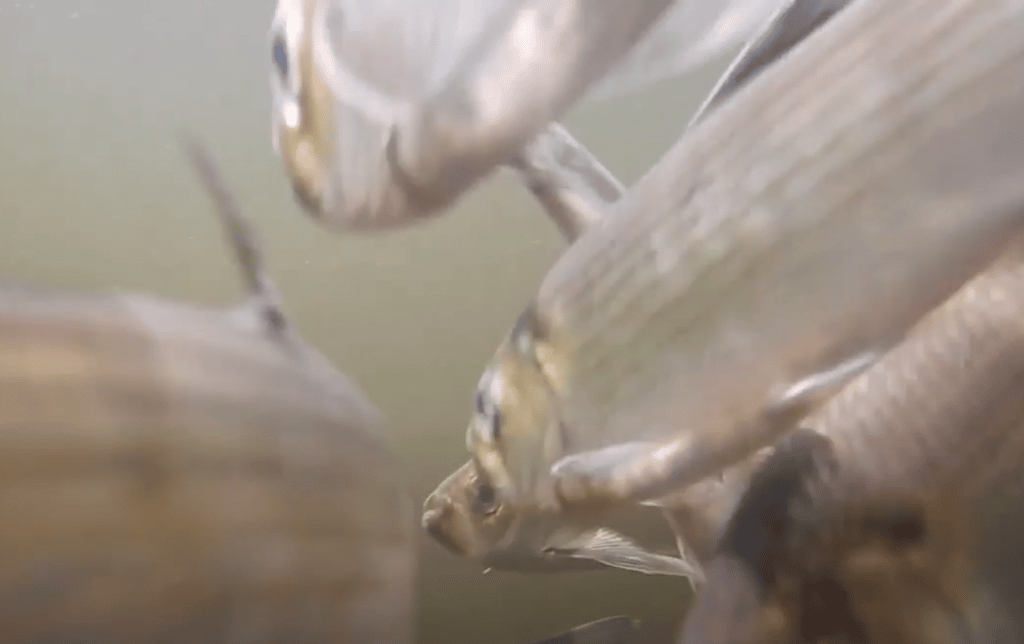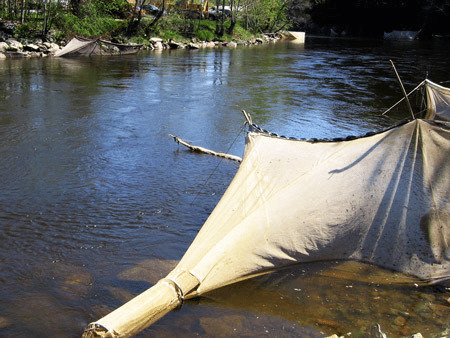
Something’s Fishy! Last week we looked at the current migration of millions of birds through the air, all making their way to seasonal feeding and nesting areas in our part of the world. This week, we’ll be exploring another one of Maine’s great migrations. This one is a bit more hidden from our sight, although no it’s less spectacular!
 Each year, millions of fish move between saltwater and freshwater habitats as part of their life cycles. Known as diadromous fish, some of these migratory fish species in Maine include alewife, American Eel, and Atlantic Salmon. Most of Maine’s diadromous fish spend their lives out at sea, and then return to freshwater rivers, lakes, and streams to lay eggs and reproduce. The American Eel does the opposite. You may have noticed lots of nets placed out along rivers and streams over the past month or so. These nets are catching elvers, the juvenile life cycle stage of the American Eel. Elvers are only a couple of inches long, but once they’re grown-up eels, they can reach four feet in length!
Each year, millions of fish move between saltwater and freshwater habitats as part of their life cycles. Known as diadromous fish, some of these migratory fish species in Maine include alewife, American Eel, and Atlantic Salmon. Most of Maine’s diadromous fish spend their lives out at sea, and then return to freshwater rivers, lakes, and streams to lay eggs and reproduce. The American Eel does the opposite. You may have noticed lots of nets placed out along rivers and streams over the past month or so. These nets are catching elvers, the juvenile life cycle stage of the American Eel. Elvers are only a couple of inches long, but once they’re grown-up eels, they can reach four feet in length!
So what’s the big deal about a bunch of fish swimming back and forth between fresh and saltwater each season? Well, first off, if you’ve never witnessed migrating fish at a local river or stream first-hand you don’t know what you’re missing. Seeing thousands of fish packed together gill to gill making their way upstream is super cool!
I took this video (below) at a local stream near my home. After spending years out in the ocean, these alewives were returning to the very same lake they were born in; amazing, right? Scientists still don’t exactly know how they do it, but some theories include chemical sensing (smell) and the ability to imprint on the magnetic field of their place of birth.
Another significant aspect of this massive seasonal migration of fish is how important it is to the ecology of Maine. These fish are an essential part of both aquatic and terrestrial food chains. Take the Alewife as an example. Birds like Bald Eagles, Osprey, Great Blue Herons, gulls, terns, cormorants, and mergansers will feed on adult fish returning to freshwater to spawn. Seals, whales, otter, mink, fox, raccoon, skunk, weasel, and fisher are some of the mammal species who rely on these fish as their prey.
For this week’s activity I invite you to learn more about some of Maine’s diadromous fish species by creating Life Cycle Wheels.
ACTIVITY PROCEDURE
- Download and print a blank life-cycle wheel (one for each species of fish).
- Start with one species of Maine diadromous fish (Alewife, American Eel, Atlantic Salmon, etc.). Draw a picture or write the name of this species in the center of your wheel.
- Next, move to the ring of months along the outside of the wheel. This is where you’ll do research for your particular species of fish. In your research you’ll need to find out what each stage of its life cycle is called (such as “egg,” “fry,” etc.). Use both text and pictures to design your wheel with the information to match the appropriate month(s).
- As an extra “layer” on your wheel, see if you can list some of the predators and prey species for your fish during different parts of its life cycle. Are the predators/prey the same for each part of your fish’s life cycle?
- Repeat these steps for each additional species. Compare the life cycles of different diadromous fish species. How are they different? How are they similar?
GET UP CLOSE AND PERSONAL
As they say, “seeing is believing.” If you’ve never before seen a group of migrating alewives maybe this is your year to do so! Alewives start to move from saltwater into freshwater streams, rivers, and lakes once the temperature gets to about 51 degrees Fahrenheit. The last couple of months in May are prime time for this. You can find an active “run” near you by downloading this Maine alewife observation map which, by the way, includes Sedgeunkedunk Stream at Fields Pond where I work. Enjoy!
NOTE FOR TEACHERS
If you’re doing this activity with your students you can expand on their research and have them draw and label anatomical diagrams of each of their chosen diadromous fish species. You can also set up a Kahoot or Quizlet game with diadromous fish life cycle or anatomy questions. As a Maine geography lesson, try having them identify all the rivers in Maine that currently support diadromous fish runs. What are the obstacles preventing fish from accessing some of Maine’s other rivers? What solutions have scientist and engineers come up with to restore diadromous fish species habitat? This activity addresses the following NGSS standards: LS2-2,3&5
Our educators, scientists, advocates, and naturalists are committed to keeping you connected to the natural world as we deal with the coronavirus situation together. Check in every weekday on our Connections page for family activities, parent/teacher tips, backyard birding, nature exploration at our sanctuaries, and more.
